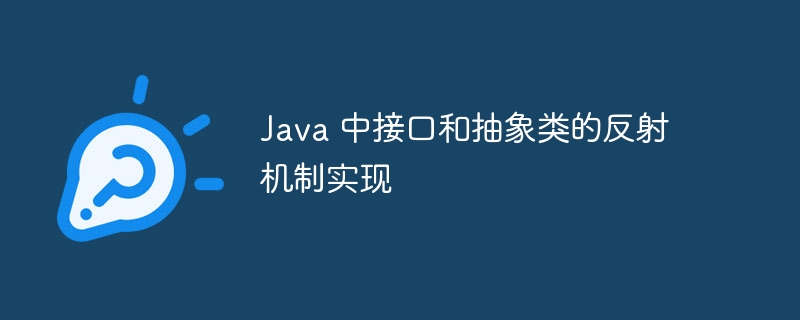 Java
Java
 javaTutorial
javaTutorial
 Reflection mechanism implementation of interfaces and abstract classes in Java
Reflection mechanism implementation of interfaces and abstract classes in Java
Reflection mechanism implementation of interfaces and abstract classes in Java
The reflection mechanism allows the program to obtain and modify class information at runtime. It can be used to implement reflection of interfaces and abstract classes: Interface reflection: Obtain the interface reflection object through Class.forName() and access its metadata (name, method and fields). Reflection of abstract classes: Similar to interfaces, you can obtain the reflection object of an abstract class and access its metadata and non-abstract methods. Practical case: The reflection mechanism can be used to implement dynamic proxies, intercepting calls to interface methods at runtime by dynamically creating proxy classes.

Implementation of interface and abstract class reflection mechanism in Java
The reflection mechanism is a feature of the Java programming language that allows programs Obtain and modify class information at runtime. It can be used to implement reflection of interfaces and abstract classes.
Reflection of interface
To obtain the reflection object of the interface, you can use Class.forName() method:
Class<?> interfaceClass = Class.forName("com.example.MyInterface");Through the reflection object of the interface, you can access the metadata of the interface, such as names, methods and fields:
System.out.println("Interface name: " + interfaceClass.getName());
// 获取接口的所有方法
Method[] methods = interfaceClass.getMethods();
for (Method method : methods) {
System.out.println("Interface method: " + method.getName());
}Reflection of abstract classes
Similar to interfaces, you can also use Class.forName() Method to obtain the reflection object of the abstract class:
Class<?> abstractClass = Class.forName("com.example.MyAbstractClass");For an abstract class, you can access its metadata and non-abstract methods:
System.out.println("Abstract class name: " + abstractClass.getName());
// 获取抽象类的所有方法
Method[] methods = abstractClass.getMethods();
for (Method method : methods) {
if (!method.isAbstract()) {
System.out.println("Non-abstract method in abstract class: " + method.getName());
}
}Practical case: dynamic proxy
The reflection mechanism can be used to implement dynamic proxy. This pattern allows creating a proxy for a class at runtime without having to define the class beforehand:
// 为 MyInterface 创建一个动态代理 InvocationHandler handler = new MyInvocationHandler(); Class<?> proxyClass = Proxy.getProxyClass(interfaceClass, handler); MyInterface proxy = (MyInterface) proxyClass.newInstance(); // 使用代理调用接口方法 proxy.someMethod();
In MyInvocationHandler we can implement invoke()## as needed # Method to intercept calls to interface methods.
The above is the detailed content of Reflection mechanism implementation of interfaces and abstract classes in Java. For more information, please follow other related articles on the PHP Chinese website!

Hot AI Tools

Undresser.AI Undress
AI-powered app for creating realistic nude photos

AI Clothes Remover
Online AI tool for removing clothes from photos.

Undress AI Tool
Undress images for free

Clothoff.io
AI clothes remover

AI Hentai Generator
Generate AI Hentai for free.

Hot Article

Hot Tools

Notepad++7.3.1
Easy-to-use and free code editor

SublimeText3 Chinese version
Chinese version, very easy to use

Zend Studio 13.0.1
Powerful PHP integrated development environment

Dreamweaver CS6
Visual web development tools

SublimeText3 Mac version
God-level code editing software (SublimeText3)

Hot Topics
 1377
1377
 52
52
 Perfect Number in Java
Aug 30, 2024 pm 04:28 PM
Perfect Number in Java
Aug 30, 2024 pm 04:28 PM
Guide to Perfect Number in Java. Here we discuss the Definition, How to check Perfect number in Java?, examples with code implementation.
 Random Number Generator in Java
Aug 30, 2024 pm 04:27 PM
Random Number Generator in Java
Aug 30, 2024 pm 04:27 PM
Guide to Random Number Generator in Java. Here we discuss Functions in Java with examples and two different Generators with ther examples.
 Weka in Java
Aug 30, 2024 pm 04:28 PM
Weka in Java
Aug 30, 2024 pm 04:28 PM
Guide to Weka in Java. Here we discuss the Introduction, how to use weka java, the type of platform, and advantages with examples.
 Smith Number in Java
Aug 30, 2024 pm 04:28 PM
Smith Number in Java
Aug 30, 2024 pm 04:28 PM
Guide to Smith Number in Java. Here we discuss the Definition, How to check smith number in Java? example with code implementation.
 Java Spring Interview Questions
Aug 30, 2024 pm 04:29 PM
Java Spring Interview Questions
Aug 30, 2024 pm 04:29 PM
In this article, we have kept the most asked Java Spring Interview Questions with their detailed answers. So that you can crack the interview.
 Break or return from Java 8 stream forEach?
Feb 07, 2025 pm 12:09 PM
Break or return from Java 8 stream forEach?
Feb 07, 2025 pm 12:09 PM
Java 8 introduces the Stream API, providing a powerful and expressive way to process data collections. However, a common question when using Stream is: How to break or return from a forEach operation? Traditional loops allow for early interruption or return, but Stream's forEach method does not directly support this method. This article will explain the reasons and explore alternative methods for implementing premature termination in Stream processing systems. Further reading: Java Stream API improvements Understand Stream forEach The forEach method is a terminal operation that performs one operation on each element in the Stream. Its design intention is
 TimeStamp to Date in Java
Aug 30, 2024 pm 04:28 PM
TimeStamp to Date in Java
Aug 30, 2024 pm 04:28 PM
Guide to TimeStamp to Date in Java. Here we also discuss the introduction and how to convert timestamp to date in java along with examples.
 Create the Future: Java Programming for Absolute Beginners
Oct 13, 2024 pm 01:32 PM
Create the Future: Java Programming for Absolute Beginners
Oct 13, 2024 pm 01:32 PM
Java is a popular programming language that can be learned by both beginners and experienced developers. This tutorial starts with basic concepts and progresses through advanced topics. After installing the Java Development Kit, you can practice programming by creating a simple "Hello, World!" program. After you understand the code, use the command prompt to compile and run the program, and "Hello, World!" will be output on the console. Learning Java starts your programming journey, and as your mastery deepens, you can create more complex applications.



